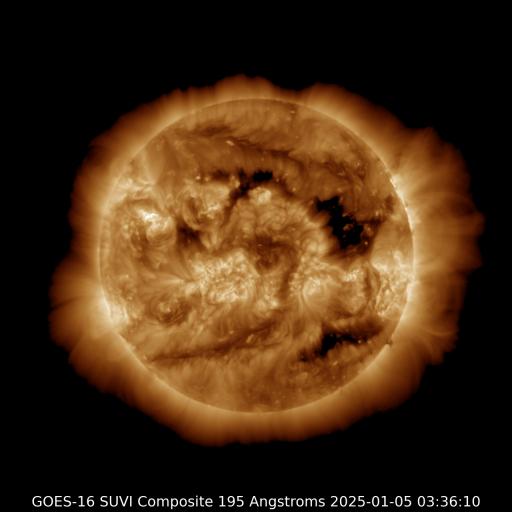Viewing archive of Thursday, 3 February 2011
Solar activity report
Any mentioned solar flare in this report has a scaling factor applied by the Space Weather Prediction Center (SWPC). Because of the SWPC scaling factor, solar flares are reported as 42% smaller than for the science quality data. The scaling factor has been removed from our archived solar flare data to reflect the true physical units.
Report of Solar-Geophysical Activity 2011 Feb 03 2200 UTCPrepared by the NOAA © SWPC and processed by SpaceWeatherLive.com
Joint USAF/NOAA Report of Solar and Geophysical Activity
SDF Number 034 Issued at 2200Z on 03 Feb 2011IA. Analysis of Solar Active Regions and Activity from 02-2100Z to 03-2100Z
Solar activity was very low. Region 1150 (S22W13)
decayed throughout the period. New Region 1152 (S18E11) was numbered
today after producing a B2 x-ray event.
IB. Solar Activity Forecast
Solar activity is expected to be very
low with a slight chance for a C-class flare for the next 3 days
(4-6 February).
IIA. Geophysical Activity Summary 02-2100Z to 03-2100Z
The geomagnetic field was very low throughout the period.
IIB. Geophysical Activity Forecast
The geomagnetic field is
forecast to be mostly unsettled to active with the chance for a
minor storm on day 1 (4 February) due to coronal hole effects in
conjunction with the anticipated arrival of the CME from 30 January.
Conditions are forecast to be mostly unsettled on day 2 (5 February)
before returning to mostly quiet on day 3 (6 February) when coronal
hole effects subside.
III. Event Probabilities 04 Feb to 06 Feb
| Class M | 01% | 01% | 01% |
| Class X | 01% | 01% | 01% |
| Proton | 01% | 01% | 01% |
| PCAF | Green | ||
IV. Penticton 10.7 cm Flux
Observed 03 Feb 080 Predicted 04 Feb-06 Feb 080/080/080 90 Day Mean 03 Feb 084
V. Geomagnetic A Indices
Observed Afr/Ap 02 Feb 005/005 Estimated Afr/Ap 03 Feb 005/005 Predicted Afr/Ap 04 Feb-06 Feb 010/010-008/008-005/005
VI. Geomagnetic Activity Probabilities 04 Feb to 06 Feb
| A. Middle Latitudes | |||
|---|---|---|---|
| Active | 30% | 25% | 20% |
| Minor storm | 40% | 10% | 05% |
| Major-severe storm | 10% | 05% | 01% |
| B. High Latitudes | |||
|---|---|---|---|
| Active | 40% | 30% | 20% |
| Minor storm | 45% | 20% | 10% |
| Major-severe storm | 15% | 10% | 01% |
All times in UTC
Current data suggests there is a slight possibility for aurora to appear at the following high latitude regions in the near future
Iqaluit, NUNuuk
Reykjavik
Latest news
Latest forum messages
Aurora photography hints for those of us with smartphones 65New satellites - Proba-3, PUNCH, SWFO-L1, GOES-U/19 46Incoming & Unnumbered Active Regions 1672AR4048 122AR 4054 19
More topicsSupport SpaceWeatherLive.com!
A lot of people come to SpaceWeatherLive to follow the Sun's activity or if there is aurora to be seen, but with more traffic comes higher server costs. Consider a donation if you enjoy SpaceWeatherLive so we can keep the website online!

Latest alerts
00:55 UTC - Coronal hole
A southern hemisphere coronal hole is facing Earth. Enhanced solar wind could arrive in ~3 days
Monday, 7 April 2025
20:45 UTC - Geomagnetic activity
Active geomagnetic conditions (Kp4) Threshold Reached: 20:39 UTC
17:33 UTC - Hemispheric Power Index
The OVATION model predicts the Hemispheric Power Index to reach 51GW at 18:18 UTC
Space weather facts
| Last X-flare | 2025/03/28 | X1.1 |
| Last M-flare | 2025/04/05 | M1.0 |
| Last geomagnetic storm | 2025/04/06 | Kp5 (G1) |
| Spotless days | |
|---|---|
| Last spotless day | 2022/06/08 |
| Monthly mean Sunspot Number | |
|---|---|
| March 2025 | 134.2 -20.4 |
| April 2025 | 148.7 +14.5 |
| Last 30 days | 134.1 -5.6 |




